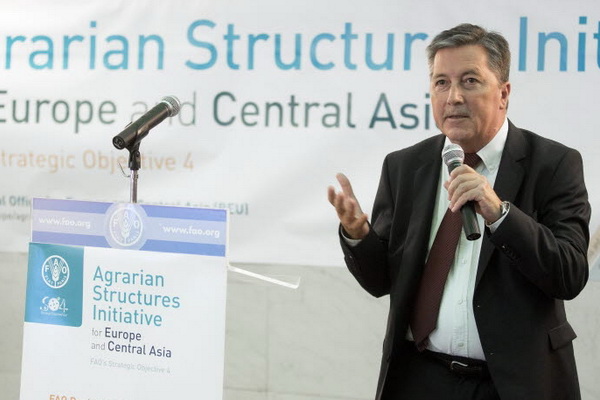Expert of UN Food and Agriculture Organization Stepan TANICH:
OVER FIVE MILLION PEOPLE UNDERNOURISHED IN CENTRAL ASIA AND CAUCASUS

Despite technological progress, millions of people around the world are living undernourished. Stepan TANICH, an expert of the Food and Agriculture Organization of the United Nations, told Interfax-Kazakhstan about how the Caucasus and Central Asian countries are dealing with this problem.
- Mr Tanich, what is the current situation in the sub-region in terms of poverty?
- To begin with, I would like to tell you that the Caucasus and Central Asian sub-region or CCA is comprised of Armenia, Azerbaijan, Georgia, Kazakhstan, Kyrgyzstan, Tajikistan, Turkmenistan and Uzbekistan. The sub-region is a mix of low- and middle-income economies.
Kazakhstan is the sub-region’s wealthiest country. Kyrgyzstan and Tajikistan are at the other end of the spectrum. Both countries have seen very poor improvements in their per capita incomes since 2000 and are largely economically dependent on remittances, mainly from Russia.
Specifically, remittances in Kyrgyzstan account for 31 percent of that country’s GDP. In Tajikistan this share stands at 48 percent, which is the highest in the world (World Bank, 2013). In general, poverty is more prevalent in rural areas than in urban areas throughout the sub-region. It is also closely related to the number of children in a household with the risk of poverty increasing with each additional child.
Another way to measure poverty is by analyzing the share of household income spent on food. Data provided by the U.S. Department of Agriculture (USDA) (2012) suggests that in most CCA countries, household final consumption expenditure on food consumed at home accounted for more than 30 percent of total household expenditure in 2012. In comparison, the average German consumer spends about 10 percent, and the average Czech spends 13 percent. However, as is with many indicators that measure food security, these are only average shares. The poorest segments of the population tend to spend a much higher percentage of their incomes on food.
- In what countries of the sub-region the problem of undernourishment is most acute?
- Kyrgyzstan, Tajikistan and Uzbekistan are three countries where prevalence of undernourishment is still higher than 5 percent.
Analysis of the relationship between income and food insecurity suggests that poverty is the major cause for undernourishment and malnutrition in all three sub-regions. The four poorest countries (Kyrgyzstan, Moldova, Tajikistan, and Uzbekistan) also ranked low with regards to the average dietary energy supply adequacy indicator.
For instance, in 2011-2013 the prevalence of undernourishment in Kyrgyzstan was at 5.9 percent or 0.3 million people. The situation in this country has considerably improved if compared to 1990-1992 when 17.7 percent of population or 0.8 million people were undernourished.
The situation in Tajikistan and Uzbekistan is cause for even greater concern. About 2 million people in Tajikistan and 1.6 million people in Uzbekistan remain undernourished or 30.2% and 5.7% of total population, respectively. For Tajikistan, the figures were 1.7 million or 30.3% in 1990-1992.
All in all, 5.5 million people or 7% of CCA population are undernourished today, compared to 9.7 million or 14.4% in 1990-1992.
- Are there any data showing what impact this situation has had on health status of the people in the sub-region?
Malnutrition, measured by caloric intake, is, however, only one aspect of food insecurity. For many countries in the European CIS, SEE and CCA sub-regions, a more significant problem is a lack of adequate micronutrient intake and the sub-optimal qualities of diets. This is where these countries often rank lower than other regions in the world.
Stunting among children under five is alarmingly high in Azerbaijan and Tajikistan. Overall, the average percentage of stunted children (under five years old) in the CCA sub-region is more than three times higher than in the European CIS sub-region (average of 6 percent).
- The Central Asia states have always been known for their fruit and vegetables. Is the diet of the population really that poor?
In a number of CCA and Southeastern Europe countries, diets remain rather monotonous. In Azerbaijan and Tajikistan people obtain more than 60 percent of their energy from starchy foods. In contrast, the share of energy derived from animal products is rather low at 16 and 10 percent respectively. However, it is important to bear in mind that these are only averages. As such, the poorest income groups tend to have even less diverse diets.
In Uzbekistan, for example, the poorest income group obtains 73 percent of its daily caloric intake from cereals and only 10 percent from dairy and meat. The richest group, in contrast, enjoys a more balanced diet; 48 percent of daily caloric intake comes from cereals and 29 percent from animal products.
Moreover, according to calculations provided by the Economic Intelligence Unit, in 2013 Azerbaijan, Tajikistan, and Uzbekistan lagged behind the world average in animal iron availability (the sum of iron derived from animal products), as well as overall protein quality, which measures the presence of nine essential amino acids in the average national diet.
For example, an average Tajik consumes less than 0.9 milligrams of animal iron each day, as opposed to an average of 3.8 mg in Kazakhstan and 4.1 mg in Russia. One of the contributing factors to malnutrition across the sub-region is the overall lack of knowledge about proper nutritional practices and the absence of relevant educational programs.
On the positive side, in the last two decades the countries of the CCA sub-region have seen increases in fruit and vegetable production, which is important for improving diets. For example, between 1991 and 2010, vegetable production in the Central Asian countries increased by 72 percent, with the highest per annum growth levels seen in Tajikistan and Uzbekistan. With regards to fruits, Central Asian production increased by 60 percent. Similar positive trends were also observed in Armenia and Azerbaijan.
Despite a positive growth in food production in Tajikistan, including meat production, a recent study shows that the nutritional value of an average Tajik’s diet falls below the level necessary to maintain physiological health in all nutrient categories except for fats. It is especially deficient in nutrients derived from fish and seafood products; in 2011 the actual consumption of such products constituted only 1.3 percent of the physiological norm requirement. This example further reinforces the important role that incomes play in safeguarding household food security.
- What are the health consequences of malnutrition for the people living in the sub-region?
One other facet of malnutrition is the increasing number of overweight people. The percentage of overweight and obese people in all three sub-regions [Caucasus and Central Asia, Southeastern Europe and Eastern European countries that belong to the CIS] greatly exceeds the world’s average, which is 34.1 percent. As such, almost 48 percent of people in the CCA countries and more than 50 percent in both European CIS and SEE countries are considered overweight or obese. In Bosnia and Herzegovina, and Turkey this figure exceeds 60 percent.
FAO projections suggest that less-developed countries in the Europe and Central Asian region are expected to have some of the highest rates of obesity in the world by 2050. This would increase the risk of diet-related, non-communicable diseases in all three sub-regions and would put increased pressure on healthcare facilities, especially in the poorer countries that have fewer financial resources at their disposal.
- In January 2014 President of Kazakhstan Nursultan Nazarbayev said Kazakhstan should start growing drought-resistant and GMO crops in addition to the natural food production. Do you think this will be expedient for Kazakhstan?
- FAO Director General José Graziano da Silva has repeatedly said that there is no need to grow GMO crops (genetically modified organisms) in order to provide enough food for the world population.
What the world needs now is to bring about the “green revolutions” in those countries that have not seen them yet. However, we may need GMO technology some time in the future if the climate and weather change significantly affects the agriculture.
Unfortunately, the agricultural policy emphasis in many countries of the CCA sub-region is currently placed on the extensive methods of expanding production with a strong focus on one or two commodities.
As such, between 1991 and 2006, Uzbekistan increased its area dedicated to wheat by 196 percent, (from 488,000 to 1.5 million hectares). This policy has enabled higher levels of production of wheat and flour. At the same time, extensive expansion of territories has resulted in marginal and less productive land being brought into production. This has led to the misuse of land, fertilizer, and water resources, while yields remain rather low in these parts of the country.
Similarly, Kazakhstan increased its total planted area by almost 42 percent since 2001; however, wheat yields have declined by 30 percent over the last ten years and are among the lowest in the sub-region.
It is important to mention that despite the rather aggressive policy of self-sufficiency that Uzbekistan is pursuing, it is one of the two countries in the sub-region with the most critical food security situation in terms of the Millenium Development Goals and World Food Summit goals. This suggests that while a focus on improving agricultural production is, without a doubt, important and necessary, it should be done in an economically efficient manner and in combination with other policy tools.
- How does the climate change affect the food security, especially in the Central Asian states?
- One of the key factors that negatively affects the stability of food supply in the Caucasus and Central Asia is related to climate change processes.
The sub-region is facing warmer temperatures and a changing hydrology, and has already seen an increase in extreme weather events, such as droughts and floods. This trend is expected to persist.
According to the World Bank report, “Adapting to Climate Change in Europe and Central Asia” (2009), all countries in the CCA sub-region (with the exception of Kazakhstan) are ranked as the most exposed in the ECA region to climate change according to the index of vulnerability to climate change.
Armenia, Tajikistan, Georgia, and Kyrgyzstan are among the top ten countries in the ECA region that are likely to experience the greatest changes in climate extremes by the end of this century.
The environmental legacy of central planning further exacerbates the potential consequences of climate change. Poor management of soil erosion, water resources, pest control, and nutrient conservation are already constraining agricultural productivity and threatening the food security of poor rural communities. For example, about 48 percent of the irrigated area in Central Asian countries is affected by salinization, ranging from 12 percent in Kyrgyzstan to 96 percent in Turkmenistan.
- To what extent do the sub-region states depend on food imports?
- Another risk related to the food stability in CCA sub-region countries is their dependency on food imports and oil exports, which makes them susceptible to price fluctuations on world commodity markets. This was demonstrated during the price spikes in 2007-08 and 2010-11. As a result of both the sharp increases of global commodity prices and wheat export restrictions implemented by Russia, Ukraine and Kazakhstan – which are the key exporters of wheat to the sub-region – a number of countries experienced significant increases in domestic prices.
For example, some estimates indicate that during the summer of 2010, prices of wheat flour increased by 35 percent in Kyrgyzstan and 37 percent in Tajikistan. In 2007, Georgia’s indicators of poverty incidence, depth and severity among rural dwellers reversed a previous contraction trend and surged upward. Consequently, the poorest households, which spent large shares of their income on food, were disproportionately affected. Sharp increases in prices also negatively affect the ability of smallholder farmers to generate enough income. While higher commodity prices can be an incentive to smallholder farmers to increase production, such farmers are often net food buyers and thus end up as net losers.
- Thank you for your time!
May, 2014
© 2025 Interfax-Kazakhstan news agency
Copying and use of these materials without reference to the source is prohibited
Archive





